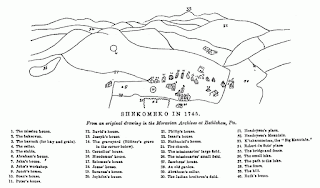Conversations (of
the electric kind on social media) with Tom Little Deer (Schaghticoke) brought
me to an interesting website {http://brianaltonenmph.com/}
where the focus is on “Public Health, Medicine and History.”
An undated post
{http://brianaltonenmph.com/6-history-of-medicine-and-pharmacy/hudson-valley-medical-history/european-multiculturalism/moravian-indian-medicine/mahican-health-and-disease/}
by Brian Altonen MPH MS begins like this:
“Transitions in
human behavior that are necessary for survival are the consequences of
acculturation. This even takes place
within missionary settings, where the original intent was “for the good” or
betterment of people’s lives, but the outcomes weren’t always what missionaries
had hoped for…”
(Altonen uses a version of this drawing on his post,
but this might be a better looking version { https://blogger.googleusercontent.com/img/b/R29vZ2xl/AVvXsEhj3OwdMNGPf73l9JCJ6dgN_Uz0NirNuZyJZ_IJEuXpW64FScOA82cMBkUIG9iXXXyvSQ69YKzEARiimiiu18_cv-fcvFwwDgBFqAjvUnr0A8Jf-5aqmUHkpInwKbk8G6l6wGf5Qw/s1600/V05-04.gif
- and that “search Google for similar images” thing let me down trying to get
to the main page I got the above from)
The blog author
hops into a bit of history recorded by Moravian Missionaries to a group of
Indigenous People using some standard “tags,” I’ll call them, that more reflect
the dominate culture’s linear view of things rather than the sort of cyclical
or circular Indigenous worldview, stating that this is a group of Mahican
People – just like you might find if you look up Shekomeko, New York at
Wikipedia where you will find that “Shekomeko (41°55'41"N
73°35'58"W) was a historic hamlet in
the southwest part of the town of North East, New York (USA) in present-day Dutchess County. It was a village of
the Mahican people.
They lived by a stream which Anglo-Americans later named Shekomeko Creek, after
their village.”
If you follow a
link there, you get a bit more info suggesting that “Moravian Bishop August
Gottlieb Spangenberg sent Christian Henry Rauch to New York City in 1740 on a
mission to preach and convert any native peoples he could find. Rauch arrived
in New York on July 16, 1740 and met with a delegation of Mahican Indians who had
come to the city to settle land issues. The Mahicans were a native Algonquian
tribe and branch of the Lenni Lenape or Delaware Nation populated the east bank
of the Hudson River in what is today eastern Dutchess County, New York, and
western Connecticut. Rauch discovered that he could converse in Dutch with the
Mahican, who were somewhat acquainted with the language from their contact with
Dutch settlements along the Hudson…”
There’s an over
simplification there for you in that phrase “land issues.”
What was going on
at the times was just a little more complicated than that, to say the least.
And it is still
on-going over in western CT, still so very complicated, especially from the
Indigenous viewpoint.
Especially if you
first read this, once again from Wikipedia, before checking the current news
stories about the Schaghticoke and Paugusset People:
“Ethnic cleansing is the systematic forced
removal of ethnic or religious groups from a given territory by a more powerful
ethnic group…Ethnic cleansing is usually
accompanied with the efforts to remove physical and cultural evidence of the
targeted group in the territory through the destruction of homes, social
centers, farms, and infrastructure, and by the desecration of monuments,
cemeteries, and places of worship.”
That last sentence, with my emphasis
added, is a powerful statement and really is the point of this blog that (mostly)
focuses on the physical and cultural evidence of Indigenous People here in
western Connecticut, the Sacred Cultural Property of the “Most Likely
Descendants” of those Ancestors, the Schaghticoke and Paugusset People. I may
tie in my observations with other People and other cultures, but mostly I’m
photographing observations that point to Stone Features of an Indigenous Ethnic
Cultural Landscape created over thousands of years that is just beginning to be
recognized and understood, despite its absence or “erasure” from the historic
record that I view as a sort of myth or outright lie.
Post Script: I first wrote “confabulation,” rather than “myth
or lie” but Wiki tells me that “Confabulation is distinguished from lying as
there is no intent to deceive and the person is unaware the information is
false” – and to be kind to the innocent people regurgitating – I mean “repeating”
– what they’ve read in all those stone wall books, I considered changing that. But
then I’d be disappointing my friend Tom Little Deer and many other open minded
people who are actually interested in the Truth about 12,000 years or so of
Human History…
Post Post Script: I’ll probably put together Part Two of
this post, citing Altonen’s Stone References that even includes a bit about a stone
sweatlodge possibility:
- which also brings me back to a post of mine, oddly enough, that make me want to do a "On Second Thought" post about the Cultural Imagery of the Stone Structure to the left in the above photo:
(I got the turtle's head wrong - and see the Serpent imagery included, doubling as the marginal scutes. This is after all a very complicated thing...)


No comments:
Post a Comment